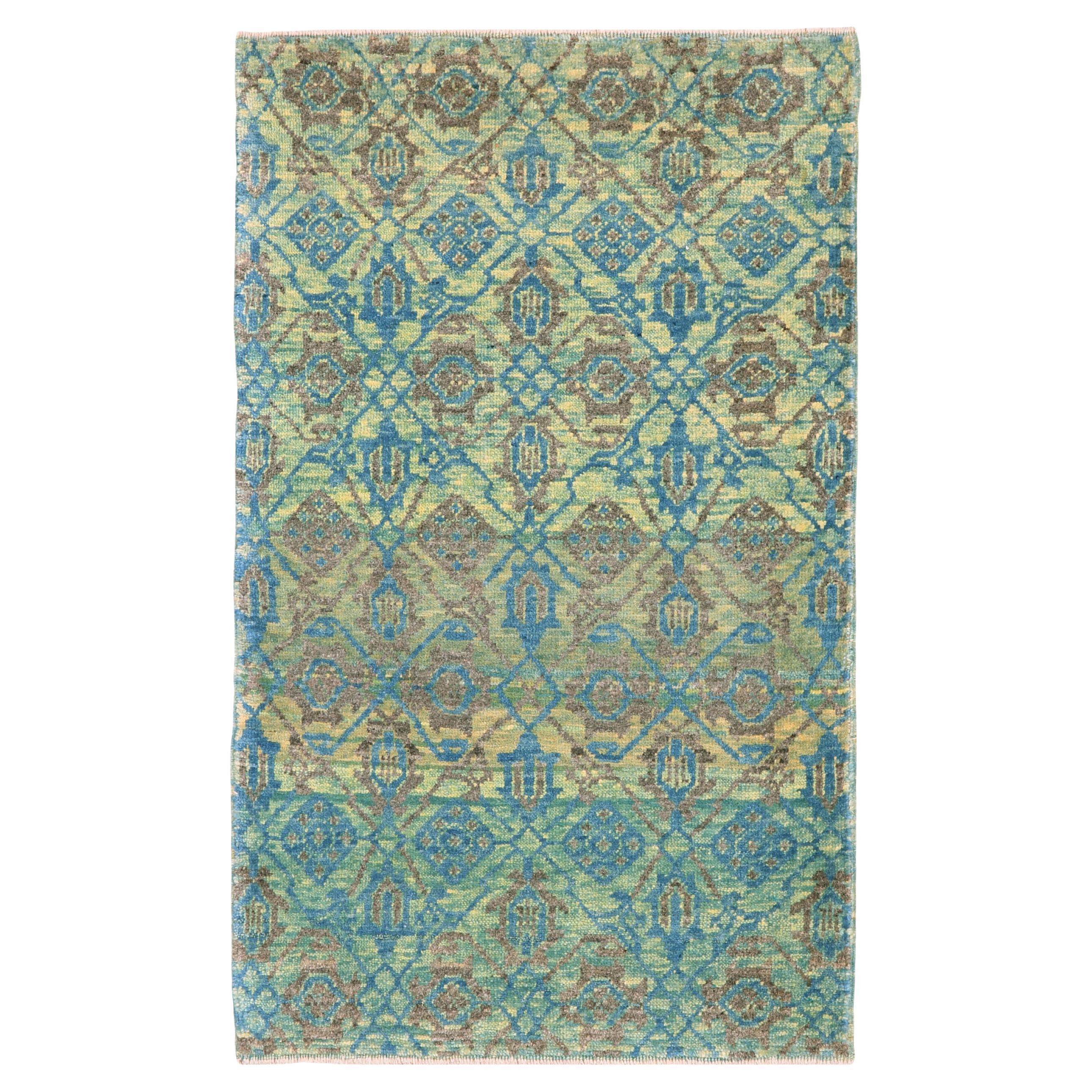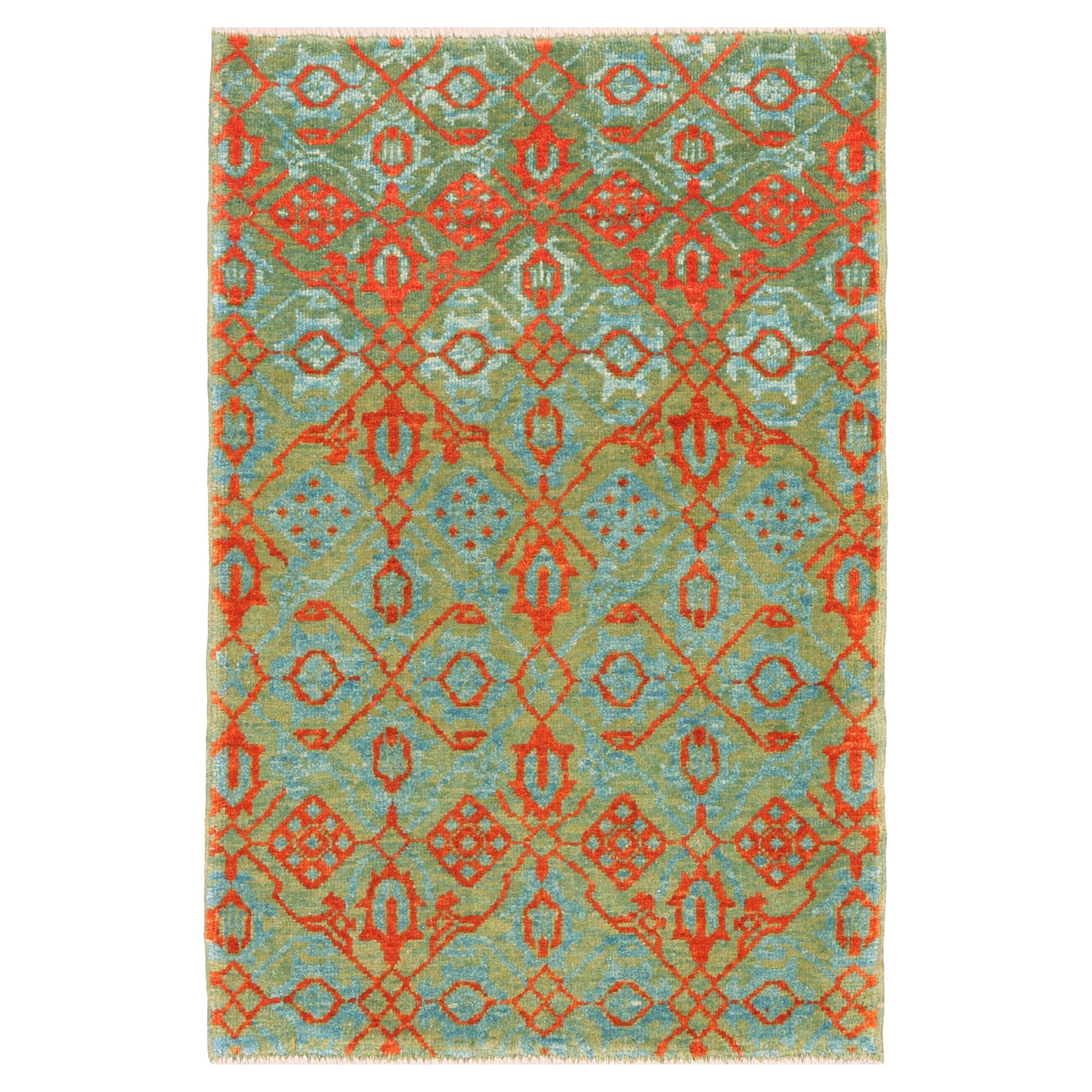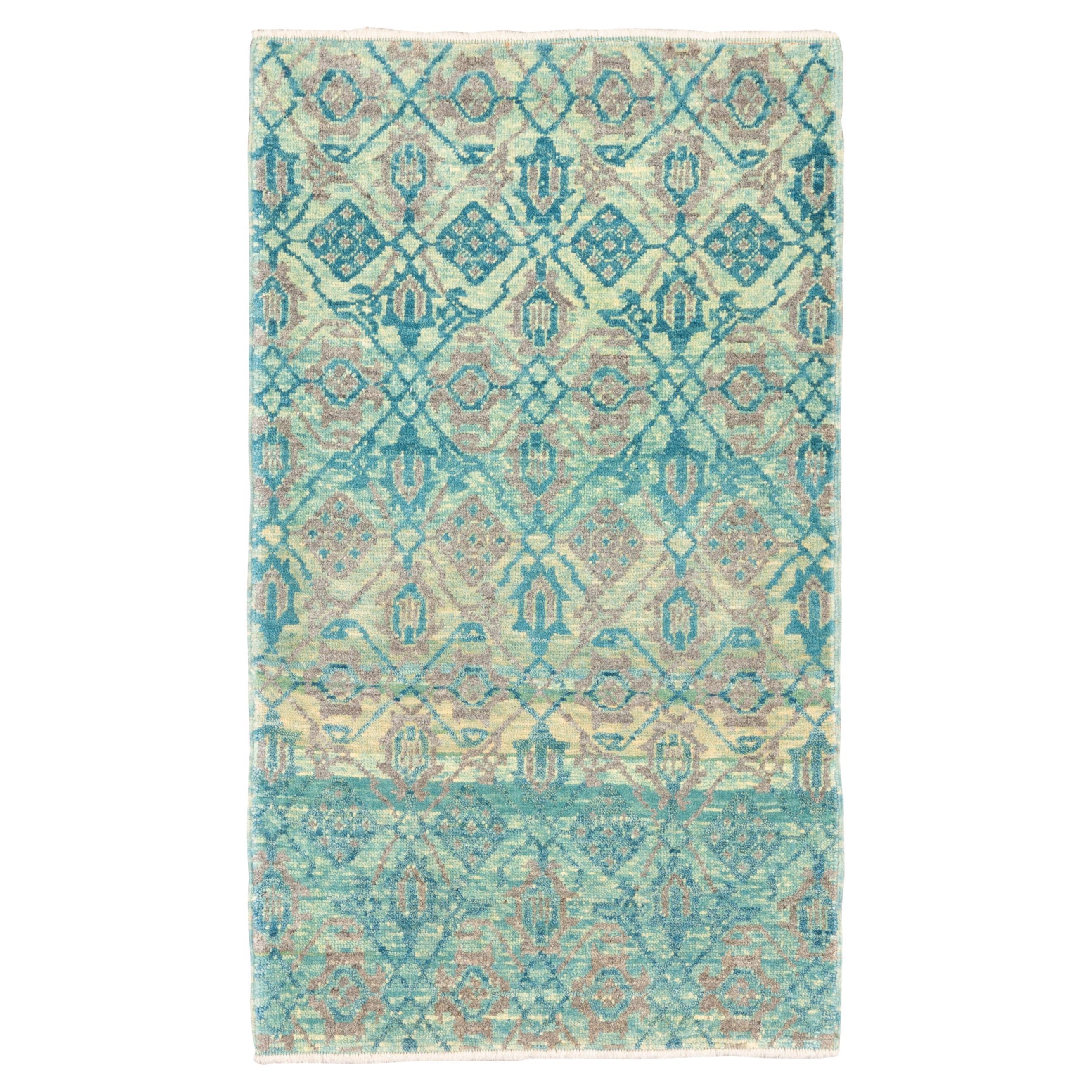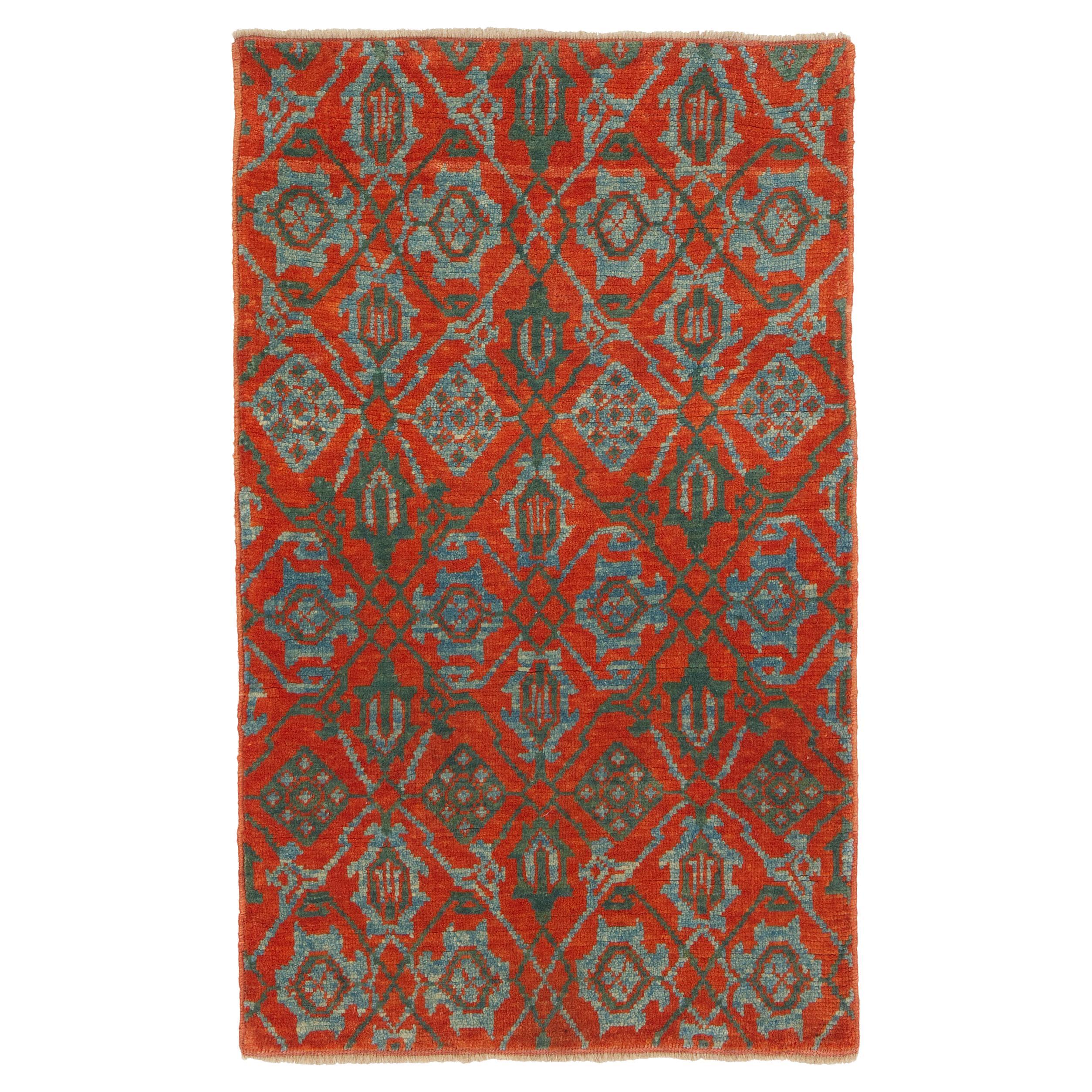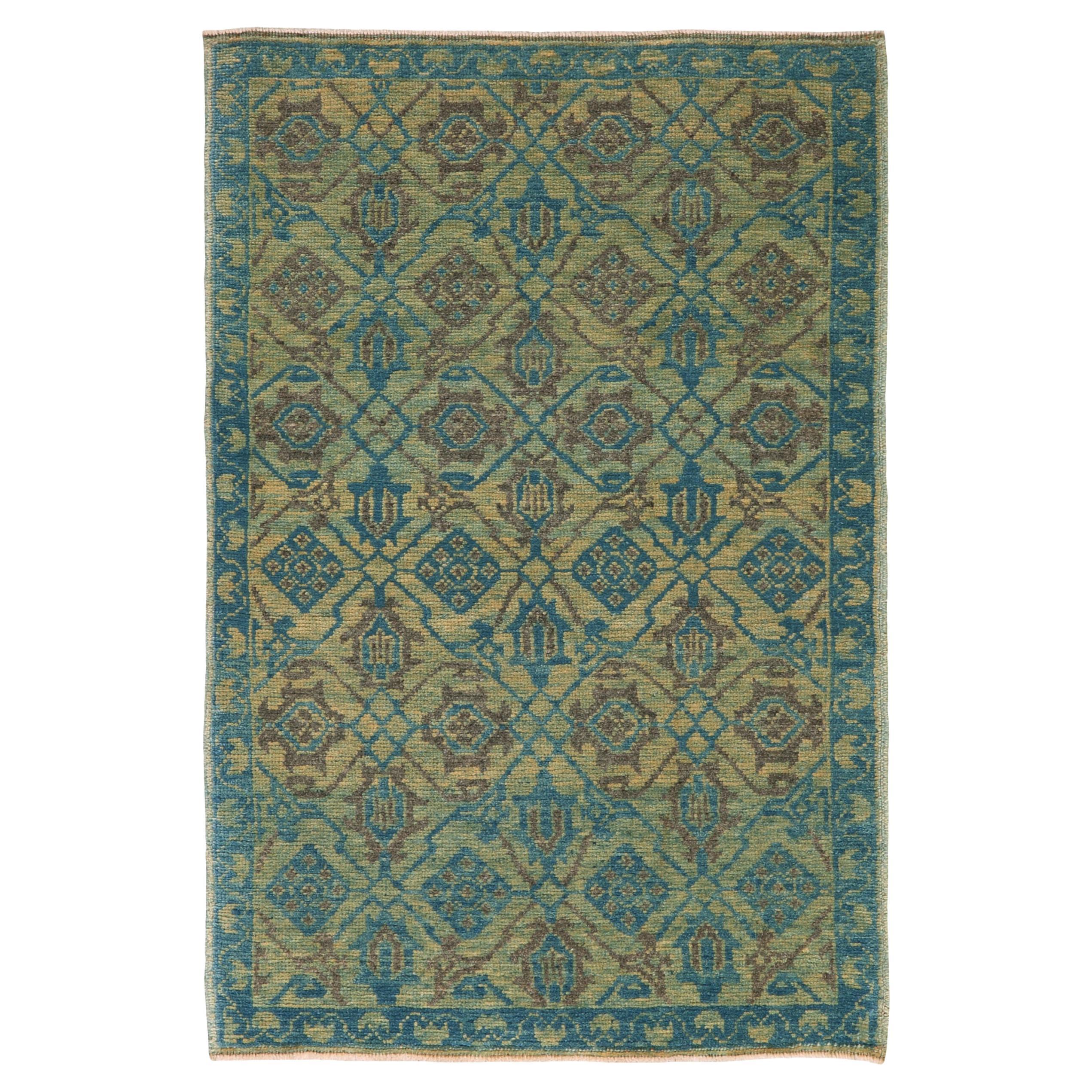Items Similar to Carpet with the pattern of ancient Mamluk carpets and light shade
Video Loading
Want more images or videos?
Request additional images or videos from the seller
1 of 18
Carpet with the pattern of ancient Mamluk carpets and light shade
About the Item
Important contemporary production carpet made entirely by hand in Turkey, which is inspired by the famous "Mamluk" carpets. Mamluks are called Egyptian-made carpets, probably from Cairo, woven in the last period of the Sultanate of the same name that ruled Egypt, Syria and Palestine from 1250 to 1517, when it was defeated by troops of the Ottoman Empire at the height of its expansion. The typical design of these artifacts is characterized by rich ornamentation to kaleidoscopic effect, with a wide variety of characteristic motifs such as small umbrella leaves that some identify as leaves of papyrus, a typically Egyptian plant. Another characteristic of these carpets is that their complex and intricate design is made with a narrow color range, normally of only three shades: red, green, and blue, which can in rare cases go up to a maximum of 6 or 7 colors, with the addition of yellow, dark brown, and ivory white, and sometimes a shade of light blue.
- Dimensions:Width: 177.96 in (452 cm)Length: 142.92 in (363 cm)
- Style:Moorish (In the Style Of)
- Materials and Techniques:Wool,Hand-Knotted
- Place of Origin:
- Period:
- Date of Manufacture:2010 ca.
- Production Type:New & Custom(One of a Kind)
- Estimated Production Time:Available Now
- Condition:
- Seller Location:Firenze, IT
- Reference Number:
About the Seller
5.0
Vetted Seller
These experienced sellers undergo a comprehensive evaluation by our team of in-house experts.
Established in 1930
1stDibs seller since 2018
29 sales on 1stDibs
Typical response time: 3 hours
- ShippingRetrieving quote...Ships From: Firenze, Italy
- Return PolicyThis item cannot be returned.
More From This SellerView All
- Large cream background rug with the patterns of ancient AgraLocated in Firenze, ITThe carpet we present is a rug with the classic Agra carpet pattern. These carpets were once produced in the ateliers of Indian courts to decorate aristocratic residences. Today the ...Category
Early 2000s Pakistani Agra Central Asian Rugs
MaterialsWool
- Vintage carpet with brown tones from tobacco to chocolateLocated in Firenze, ITVintage carpets were created to redevelop artifacts for which restoration would be too costly and anti-commercial. In fact, the idea is to enhance their worn appearance by using dyes...Category
Late 20th Century Turkish Rustic Turkish Rugs
MaterialsWool
- Turkish Kilim Konia Light Blue Background Decorated with Ram's HornLocated in Firenze, ITThose who know the language of the Kilim read it like a book understanding what the weaver tells. Like a mirror, the Kilim reflects the life of the woman who wove it and the culture ...Category
Antique 1890s Turkish Kilim Turkish Rugs
MaterialsWool
- Large Oushak Carpet Silver Colored WoolLocated in Firenze, ITThe Oushaks (Usak in Turkish) were very famous Ottoman carpets, which were made between the 14th century and the 14th century. and the seventeenth century. in Usak city of the same n...Category
2010s Turkish Oushak Turkish Rugs
MaterialsWool
- 20th Century Tulu Hand-Knotted Carpet by Wool Geometric Design Grey and CobaltLocated in Firenze, ITTulu with large central cobalt blue polygon on a natural wool bottom Tulu is Turkish rugs with a high and irregular pile, with straightforward decorations and bright colours, mainly...Category
Mid-20th Century Turkish Tulu Turkish Rugs
MaterialsWool
- Light-colored background rug with rotten green border traditional design without medallionLocated in Firenze, ITThis is a new generation Turkish carpet. Hand-knotted with wool warp and weft, it re-proposes in technique and decoration the classic themes of ancient Oushak rugs, but renewed in th...Category
2010s Turkish Oushak Turkish Rugs
MaterialsWool
You May Also Like
- Ararat Rugs Mamluk Wagireh Rug with Lattice Pattern Design Egypt Revival CarpetBy Ararat RugsLocated in Tokyo, JPThis lattice pattern is composed of palmettes and leaves filling the various compartments against the imposing ground. One has the impression that it is only part of a larger scheme designed 15th-century rug from the Mamluk era, Cairo region, Eygpt. These designs have often been described as wagirehs or samplers and were said to have been used as weaver`s aids, or for demonstration purposes, made as a template or pattern for the carpet design and production of larger rugs, they are generally small pieces of the size of a scatter rug or mat. Mamluk carpets originated in a physical environment that lacked the combination of abundant marginal grazing land and a temperate climate with cool winters that were common to most carpet-weaving areas in the Islamic world. While related to a broader tradition of Turkish weaving centered in Anatolia, far to the north, the designs of these carpets include atypical elements, such as stylized papyrus plants, that are deeply rooted in Egyptian tradition. Their unusual composition and layout probably represent an attempt to develop a distinctive product that could in effect establish a “Mamluk brand” in the lucrative European export market. The uncharacteristic color scheme—devoid of the undyed white pile and employing a limited range of three or five hues in much the same value—also suggests a conscious attempt to create a particular stylistic identity. Also virtually unique in the world of Islamic carpets is the S-spun wool. It has been argued that the tradition of clockwise wool spinning originated in Egypt because of the earlier Egyptian tradition of spinning flax into linen thread. Details of the plant’s botanical structure make it impossible to spin flax fiber in the more common counterclockwise direction utilized throughout the Middle East for wool and cotton. Mamluk carpets with the color combinations seen in the Simonetti are now generally accepted as part of an earlier tradition that has many links to the weaving of Anatolia, Iran, and Syria. The “three-color” Mamluk carpets, well represented in the Metropolitan’s collection, represent a later development that continued well after the Ottoman conquest of Egypt in 1517. Many such carpets may have been produced well into the seventeenth century, and possibly even later. (Walter B. Denny in [Ekhtiar, Soucek, Canby, and Haidar 2011]). The design of the rug is interpreted by our designers from our Mamlouk-type rugs collection and soft colors are used for this rug. Color summary: 3 colors in total; Moss Green 27 (Spurge – Indigo) Mount Olive...Category
21st Century and Contemporary Turkish Revival Turkish Rugs
MaterialsWool, Natural Fiber, Organic Material
- Ararat Rugs Mamluk Wagireh Rug Lattice Pattern Revival Carpet Natural DyedBy Ararat RugsLocated in Tokyo, JPThis lattice pattern is composed of palmettes and leaves filling the various compartments against the imposing ground. One has the impression that it is only part of a larger scheme ...Category
21st Century and Contemporary Turkish Revival Turkish Rugs
MaterialsWool, Natural Fiber, Organic Material
- Ararat Rugs Mamluk Wagireh Rug Lattice Pattern Revival Carpet Natural DyedBy Ararat RugsLocated in Tokyo, JPThis lattice pattern is composed of palmettes and leaves filling the various compartments against the imposing ground. One has the impression that it is only part of a larger scheme designed 15th-century rug from the Mamluk era, Cairo region, Eygpt. These designs have often been described as wagirehs or samplers and were said to have been used as weaver`s aids, or for demonstration purposes, made as a template or pattern for the carpet design and production of larger rugs, they are generally small pieces of the size of a scatter rug or mat. Mamluk carpets originated in a physical environment that lacked the combination of abundant marginal grazing land and a temperate climate with cool winters that were common to most carpet-weaving areas in the Islamic world. While related to a broader tradition of Turkish weaving centered in Anatolia, far to the north, the designs of these carpets include atypical elements, such as stylized papyrus plants, that are deeply rooted in Egyptian tradition. Their unusual composition and layout probably represent an attempt to develop a distinctive product that could in effect establish a “Mamluk brand” in the lucrative European export market. The uncharacteristic color scheme—devoid of the undyed white pile and employing a limited range of three or five hues in much the same value—also suggests a conscious attempt to create a particular stylistic identity. Also virtually unique in the world of Islamic carpets is the S-spun wool. It has been argued that the tradition of clockwise wool spinning originated in Egypt because of the earlier Egyptian tradition of spinning flax into linen thread. Details of the plant’s botanical structure make it impossible to spin flax fiber in the more common counterclockwise direction utilized throughout the Middle East for wool and cotton. Mamluk carpets with the color combinations seen in the Simonetti are now generally accepted as part of an earlier tradition that has many links to the weaving of Anatolia, Iran, and Syria. The “three-color” Mamluk carpets, well represented in the Metropolitan’s collection, represent a later development that continued well after the Ottoman conquest of Egypt in 1517. Many such carpets may have been produced well into the seventeenth century, and possibly even later. (Walter B. Denny in [Ekhtiar, Soucek, Canby, and Haidar 2011]). The design of the rug is interpreted by our designers from our Mamlouk-type rugs collection and soft colors are used for this rug. Color summary: 3 colors in total; Moss Green 27 (Spurge – Indigo) Mount...Category
21st Century and Contemporary Turkish Revival Turkish Rugs
MaterialsWool, Natural Fiber, Organic Material
- Ararat Rugs Mamluk Wagireh Rug Lattice Pattern Revival Carpet Natural DyedBy Ararat RugsLocated in Tokyo, JPThis lattice pattern is composed of palmettes and leaves filling the various compartments against the imposing ground. One has the impression that it is only part of a larger scheme ...Category
21st Century and Contemporary Turkish Revival Turkish Rugs
MaterialsWool, Natural Fiber, Organic Material
- Ararat Rugs Mamluk Wagireh Rug Lattice Pattern Revival Carpet Natural DyedBy Ararat RugsLocated in Tokyo, JPThis lattice pattern is composed of palmettes and leaves filling the various compartments against the imposing ground. One has the impression that it is only part of a larger scheme ...Category
21st Century and Contemporary Turkish Revival Turkish Rugs
MaterialsWool, Natural Fiber, Organic Material
- Ararat Rugs Mamluk Wagireh Rug Lattice Pattern Revival Carpet Natural DyedBy Ararat RugsLocated in Tokyo, JPThis lattice pattern is composed of palmettes and leaves filling the various compartments against the imposing ground. One has the impression that it is only part of a larger scheme designed 15th century rug from the Mamluk era, Cairo region, Eygpt. These designs have often been described as wagirehs or samplers and were said to have been used as weaver`s aids, or for demonstration purposes, made as a template or pattern for the carpet design and production of larger rugs, they are generally small pieces of the Size of a scatter rug or mat. Mamluk carpets originated in a physical environment that lacked the combination of abundant marginal grazing land and a temperate climate with cool winters that were common to most carpet-weaving areas in the Islamic world. While related to a broader tradition of Turkish weaving centered in Anatolia, far to the north, the designs of these carpets include atypical elements, such as stylized papyrus plants, that are deeply rooted in Egyptian tradition. Their unusual composition and layout probably represent an attempt to develop a distinctive product that could in effect establish a “Mamluk brand” in the lucrative European export market. The uncharacteristic color scheme—devoid of the undyed white pile and employing a limited range of three or five hues in much the same value—also suggests a conscious attempt to create a particular stylistic identity. Also virtually unique in the world of Islamic carpets is the S-spun wool. It has been argued that the tradition of clockwise wool spinning originated in Egypt because of the earlier Egyptian tradition of spinning flax into linen thread. Details of the plant’s botanical structure make it impossible to spin flax fiber in the more common counterclockwise direction utilized throughout the Middle East for wool and cotton. Mamluk carpets with the color combinations seen in the Simonetti are now generally accepted as part of an earlier tradition that has many links to the weaving of Anatolia, Iran, and Syria. The “three-color” Mamluk carpets, well represented in the Metropolitan’s collection, represent a later development that continued well after the Ottoman conquest of Egypt in 1517. Many such carpets may have been produced well into the seventeenth century, and possibly even later. (Walter B. Denny in [Ekhtiar, Soucek, Canby, and Haidar 2011]). The design of the rug is interpreted by our designers from our Mamlouk-type rugs collection and soft colors are used for this rug. Color summary: 3 colors in total; Moss Green 27 (Spurge – Indigo) Feldgrau 340 (Spurge – Madder Root – Indigo – Walnut Husk) Mount Olive...Category
21st Century and Contemporary Turkish Revival Turkish Rugs
MaterialsWool, Natural Fiber, Organic Material
Recently Viewed
View AllMore Ways To Browse
Walnut Turned
Led Wall Art
Opal Glass
Vintage Marble Top Tables
Vintage Marble Topped Table
Two Maisons
Vintage Marble Table Top
Vintage Original Listed
Very Large Boxes
Sterling Silver Knives
Mid Century White Glass Lamp
Glass Marble Table
Tiered Midcentury
Used Sofa And Chair
Used Sofas And Chairs
1890s Art
Used Vanity Furniture
Pair Of Midcentury Brass Lamps
